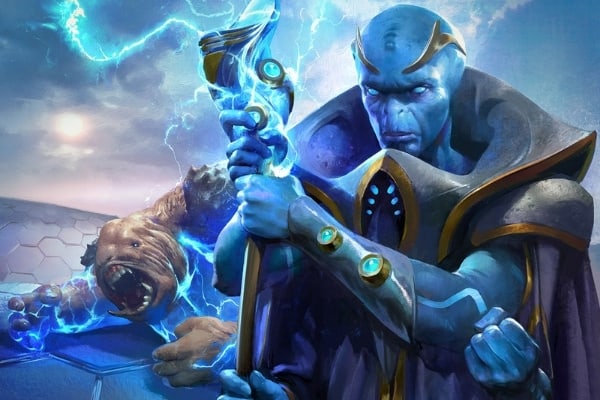Last Updated on November 24, 2023
While the Vedalken have only been an official playable race since Guildmaster’s Guide to Ravnica was published in 2018, the race has actually been around since 2003.
Vedalken
Vedalken are tall and slender, standing almost a head taller than humans but weighing about the same. Their hairless skin comes in a range of shades of blue. Their eyes are darker shades of blue or violet. They lack external ears, their noses are broad and flat, and they are partially amphibious.
- Ability Score Increase. Your Intelligence score increases by 2, and your Wisdom score increases by 1.
- Age. Vedalken mature slower than humans do. reaching maturity around age 40. Their life span is typically 350 years, with some living to the age of 500.
- Alignment. Vedalken are usually lawful and non-evil.
- Size. Tall and slender, Vedalken stand 6 to 6 1/2 feet tall on average and usually weigh less than 200 pounds. Your size is Medium.
- Speed. Your base walking speed is 30 feet.
- Vedalken Dispassion. You have advantage on all Intelligence, Wisdom, and Charisma saving throws.
- Tireless Precision. You are proficient in one of the following skills of your choice: Arcana, History, Investigation, Medicine, Performance, or Sleight of Hand. You are also proficient with one tool of your choice.
Whenever you make an ability check with the chosen skill or tool, roll a d4 and add the number rolled to the check’s total.
- Partially Amphibious. By absorbing oxygen through your skin, you can breathe underwater for up to 1 hour. Once you’ve reached that limit, you can’t use this trait again until you finish a long rest.
- Languages. You can speak, read, and write Common, Vedalken, and one other language of your choice.
What Classes Are Well Suited to the Vedalken?
Vedalkens make amazing wizards or artificers. On the basis of their intelligence boost alone, this is obvious, but their other abilities tie in excellently.
Wizard – Wizards, if you were unaware, are spellcasters. What this means for them is that they’ll often find themselves up against other spellcasters or magical entities.
It’s not a written rule that casters go against casters, but it’s pretty common that you’ll see this.
Getting advantage on those saving throws means that you’re far more secure than your average wizard of any other race, since you are protected from mental onslaught.
Artificer – Artificers automatically gain proficiency in the tools they need to get their job done since tools are used for their spellcasting and infusing.
Unfortunately, proficiencies don’t stack, but that doesn’t mean you can’t choose your preferred tool with the vedalken’s tireless precision as well, just to nab that extra 1d4 on top.
Doing so will set you ahead of other artificers by bounds.
Vedalken Appearance

Vedalkens, if you haven’t already guessed, are blue! These vulcan smurfs are tall, slender humanoids, standing generally about a foot taller than humans, while still weighing the same on average.
Their faces resemble a human’s face as well, with a few notable differences. Their eyes are dark blue or purple tones. They have no hair, not just on their head, but across their whole body.
They sport long oval ears that are pulled tight against their proportionately long heads. Their noses are broad and flat.
Vedalkens also tend to have six fingers, with the sixth acting like a second thumb on the other side of one’s hand.
Interestingly, there are vedalkens from other planes with different appearances. If you’re bringing your vedalken from a plane called Mirrodin, they likely have a few mutations that have become commonplace over the ages.
Mirrodin vedalken have four arms and gills, a result of a slow poisoning from spores released by an organism known as the mycosynth.
Vedalken Names: Male, Female
Vedalken naming culture follows a pretty standard procedure. Children are given names at birth, and then as they grow up some choose to take on new names.
Typically, vedalkens avoid familial names.
Male Names: Aglar, Bellin, Daglid, Firellan, Koplony, Lovar, Modar, Ovlan, Uldin, Zataz
Female Names: Azi, Barvisa, Brazia, Direlle, Fainn, Hallia, Katrille, Koven, Ossya
- About Author
- Latest Posts
As a kid, I was often told to get my head out of the clouds and to stop living in a fantasy world. That never really jived with me, so I decided to make a living out of games, stories, and all sorts of fantastical works. Now, as an adult, I aspire to remind people that sometimes a little bit of fantasy is all you need when life gets to be too much.
